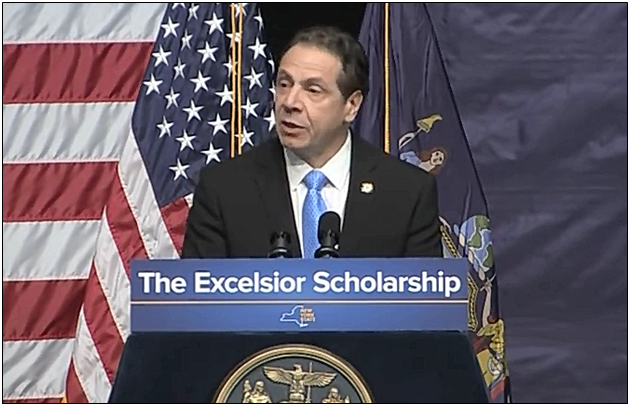By Natalia Castro
New York is truly Hillary Clinton’s home state; which is why it is no surprise the state became the first in the country to adopt a full tuition scholarship to provide essentially “free” college attendance for students living in the state, similar to what Clinton had proposed nationally on the campaign trail. This ambitious effort passed through the New York state legislature provides full funding for tuition at state two-year and four-year colleges and universities based on income; however, while New York claims to be expanding opportunity in education, they’re using artificial wealth to drown their economy.
New York Governor Andrew Cuomo proposed the Excelsior Scholarship in the state’s $153 billion budget plan, to cover tuition costs provided families earn less than $125,000 a year. Families earning up to $100,000 a year would be eligible in the scholarships first year of implementation, and by the third, the threshold will increase and stabilize at $125,000 a year.
According to the Governor’s office, “Based on enrollment projections, the plan will cost approximately $163 million per year once fully phased in.”
Cuomo defended the plan, explaining, “Today, college is what high school was — it should always be an option even if you can’t afford it. With this program, every child will have the opportunity that education provides.”
College attendance has expanded, but access is not the problem — if anything over-access is a much greater problem Cuomo is prolonging.
By creating more artificial demand for a college degree, it becomes less valuable to the millions of Americans already in the labor force. College degrees are no longer preparing students for success in the current economy, they have lost their value because of their expansion.
Millennials are now the largest and the most college educated generation in history, yet more and more are leaving the labor force. Bureau of Labor Statistics data shows labor participation for 25-34 year olds has dropped from an annual, unadjusted average of 84.6 percent in 2000 to 81.6 percent, accounting for 1.3 million millennials who never entered the labor force on a net basis if labor participation had remained at the same rate.
Bloomberg’s Richard Vedder explains how the drop in labor participation this cripples our overall labor field and the ability for students to succeed. Vedder writes, “the number of new college graduates far exceeds the growth in the number of technical, managerial, and professional jobs where graduates traditionally have gravitated…we have a new phenomenon: underemployed college graduates doing jobs historically performed by those with much less education. We have, for example, more than 100,000 janitors with college degrees, and 16,000 degree-holding parking lot attendants.”
Massive incentives to attend college, like Cuomo’s, only perpetuate the idea that everyone should go to college, and that is simply untrue. Expanding funding for college education does not allow underprivileged children the opportunity for a genuine education, it offers them an artificial degree Cuomo has told them they “should” have but is increasingly failing to secure career prospects.
Regenerating the mentality that college is the new high school transmits the idea that college is for everyone, ignoring the economic and individual value of alternate paths like entering the workforce.
As students flood into their now free colleges, college costs will continue to rise and Cuomo will fall into a similar trap as Clinton’s plan.
Tuition has an average growth rate of 6.61 percent since 1970; similarly, public university enrollment has grown over time as well, with an average annual growth rate of 1.34 percent.
As Forbes.com columnist Andrew Kelly explained in an Oct. 2015 report, colleges inflate tuition prices when they receive greater government aid. Under Cuomo’s plan university enrollment will boost and universities will be forced to expand to accommodate, continuing to raise costs over time.
Universities will experience even greater trials as they are forced to keep these students longer than just four years. The National Center for Education Statistics’ most recent numbers show, only about 34 percent of students at public institutions even graduate in four years. With an increase in the number of students going to school while struggling with work and childcare responsibilities, these programs will pay for students’ educations for significantly longer than just four years even if these students attend four year institutions.
As Kelly warned, “The exact relationship between aid and tuition increases — whether it causes or enables — is actually less important from a policymaking perspective because the end effect is the same: more aid, higher tuition prices. That’s why simply pouring more aid into the system won’t create affordable college. To get there, we need reforms that actually change the incentives for colleges.”
Tuition free college does not fulfill a dream of adequate access, it simply devalues the degree and raises costs for everyone. College is meant to prepare students for the real world, it is not Cuomo’s holding cell for students while the economy and their own personal growth fail.
Natalia Castro is a contributing editor at Americans for Limited Government.








